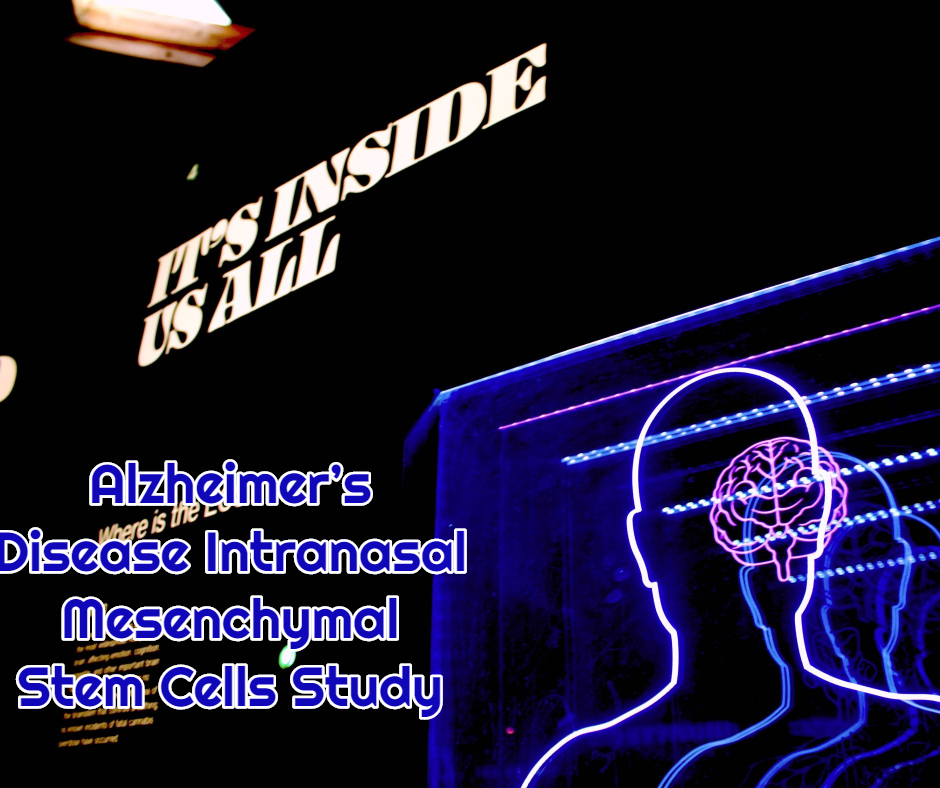Alzheimer’s Disease Intranasal Mesenchymal Stem Cells Study Abstract
This page is a review of the Alzheimer’s Disease Intranasal Mesenchymal Stem Cells Study. At Dream Body Clinic we deal with Alzheimer’s Disease Dementia and Stem Cell Therapy. For Alzheimer’s and dementia we use 50 million mesenchymal stem cells that are injected intrathecal (into the spinal fluid). These mesenchymal stem cells are able to travel from the spinal fluid to the cerebral fluid where they can guide the cellular repair of damage from Alzheimer’s and dementia. Learn about Dream Body Clinic Alzheimer’s Stem Cell Treatment Here. This treatment has shown tremendous results in cognition and verbal response in patients. Read the following study to learn more about the deep details of how mesenchymal stem cells can treat Alzheimer’s and Dementia. The following is the Alzheimer’s Disease Intranasal Mesenchymal Stem Cells Study Abstract.
In view of the rapid preclinical development of cell-based therapies for neurodegenerative disorders, traumatic
brain injury, and tumors, the safe and efficient delivery and targeting of therapeutic cells to the central nervous
system is critical for maintaining therapeutic efficacy and safety in the respective disease models. Our previous
data demonstrated therapeutically efficacious and targeted delivery of mesenchymal stem cells (MSCs) to the
brain in the rat 6-hydroxydopamine model of Parkinson’s disease (PD). The present study examined delivery
of bone marrow-derived MSCs, macrophages, and microglia to the brain in a transgenic model of PD [(Thy1)-
h[A30P] aS] and an APP/PS1 model of Alzheimer’s disease (AD) via intranasal application (INA). INA of
microglia in naive BL/6 mice led to targeted and effective delivery of cells to the brain. Quantitative PCR
analysis of eGFP DNA showed that the brain contained the highest amount of eGFP-microglia (up to 2.1 × 104)
after INA of 1 × 106 cells, while the total amount of cells detected in peripheral organs did not exceed 3.4 × 103.
Seven days after INA, MSCs expressing eGFP were detected in the olfactory bulb (OB), cortex, amygdala, striatum,
hippocampus, cerebellum, and brainstem of (Thy1)-h[A30P] aS transgenic mice, showing predominant
distribution within the OB and brainstem. INA of eGFP-expressing macrophages in 13-month-old APP/PS1
mice led to delivery of cells to the OB, hippocampus, cortex, and cerebellum. Both MSCs and macrophages
contained Iba-1-positive population of small microglia-like cells and Iba-1-negative large rounded cells showing
either intracellular amyloid b (macrophages in APP/PS1 model) or a-synuclein [MSCs in (Thy1)-h[A30P]
aS model] immunoreactivity. Here, we show, for the first time, intranasal delivery of cells to the brain of transgenic
PD and AD mouse models. Additional work is needed to determine the optimal dosage (single treatment
regimen or repeated administrations) to achieve functional improvement in these mouse models with intranasal
microglia/macrophages and MSCs. This manuscript is published as part of the International Association of
Neurorestoratology (IANR) special issue of Cell Transplantation.
Key words: Intranasal; Mesenchymal stem cells (MSCs); Macrophages; Alzheimer’s disease;
Parkinson’s disease; Amyloid beta (Ab)
Alzheimer’s Disease Intranasal Mesenchymal Stem Cells Study – FULL STUDY BELOW
intranasal-bmac-for-parkinsons-and-alzheimers-on-mice